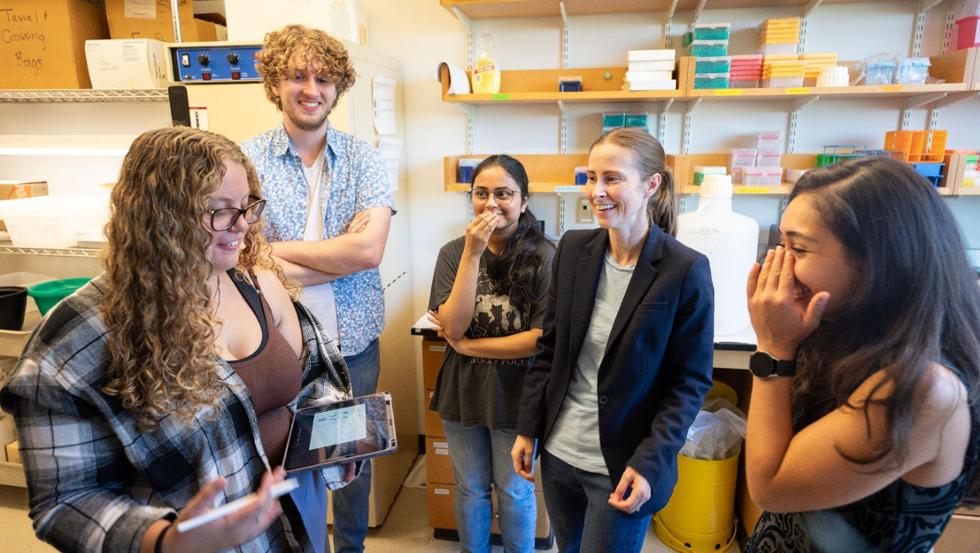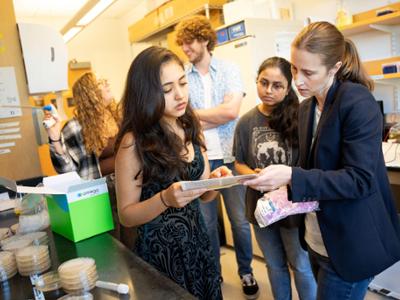
This summer, students led by Associate Professor of Biology Natalie Nannas explored a decades-old biological curiosity. In the 1940s, food scientists noticed that a particular chromosome repeatedly produced purple kernels in maize, despite their best efforts to breed it out. “They were trying to get perfectly yellow corn, and were like — it’s not even that half the corn is purple, 80% of it is,” explained Will Burns ’25.
This observation led to the discovery of meiotic drive, whereby one version of a chromosome’s genetic information is passed on “at a higher-than-expected rate,” Nannas said. “So it’s skewing and cheating the inheritance, which is weird because the foundational law of genetics is that you can pass on either chromosome with 50-50 probability.”
Natalie Nannas
Associate Professor of Biology
Areas of Expertise: Genetics, molecular and cellular biology, and bioethics
While such instances have been identified across a number of species, Nannas noted that the “selfish” chromosome in maize is of particular interest. Its name is abnormal chromosome 10 (Ab10 for short), and it displays a unique form of meiotic drive that researchers have been attempting to understand.
The remarkable potency of Ab10’s meiotic drive appears tied to its mechanism of segregation. During meiosis, genetic material divides into four “daughter” cells, each with half the chromosomes of the original “parent” cell. Chromosome segregation occurs twice during meiosis, when two halves of a chromosome (chromatids) separate and move to opposite poles of the cell nucleus. With Ab10 chromosomes, this takes place unequally and preferentially, meaning they can promote their genetic information at an unusually high rate.
“[Ab10] has a genetic advantage, because it’s separating faster than the other chromosomes,” Brianna Padilla ’25 said.
Understanding the function of Ab10’s meiotic drive was only the first part of this summer’s research. “We’ve genetically modified yeast to have the same system and hopefully show the same strange signs of inheritance,” Burns said. To do this, the team “identified all the genes that we think are controlling this and moved them over into the yeast,” Nannas explained.
Padilla detailed the process further, saying that “we had to test whether Kindr or Trkin [two kinds of motor proteins] was the main cause of early separation in the abnormal chromosomes.”
To modify the yeast, the team used a technique called genetic transformation, a process by which outside DNA is incorporated into a cell. “Basically, under the right conditions, yeast can be persuaded to take up foreign DNA and integrate it into a random part of its own genetic code,” Burns explained. While genetic transformation lacks the exact precision of gene-editing technology like CRISPR-Cas9 (which some students use for coursework and which Nannas uses in her own research), it was nonetheless capable of splicing specific genes into yeast. “It's basically a shotgun strategy. We just need the new gene to stick; we don't care where,” Burns noted. “Yeast’s natural ability to clumsily suck up DNA is good enough.”
Nannas emphasized the method’s valuable agricultural potential, especially as the climate becomes increasingly volatile. “What we could do with this system is skew the inheritance of a gene we desire, as a way to quickly adapt to changing agricultural conditions.”
The students were tasked with setting up and monitoring numerous yeast cultures, as they tested how to best integrate this outside DNA into their samples. To nourish the yeast, they mixed and distributed culture media, substances that provide the necessary nutrients and minerals for growth. After sterilizing the media in an autoclave and feeding them to the yeast, the students observed the cultures to determine whether or not the key chromosomes were inherited.
By the end of the summer, the students in Nannas’ lab had proven that the Ab10 gene that codes for the motor protein Kindr was capable of creating skewed inheritance in yeast, the same genetic cheating that was seen in the purple corn.

Nannas emphasized the method’s valuable agricultural potential, especially as the climate becomes increasingly volatile. As of now, breeding crops that are both high-yielding and disease-resistant usually takes about 10 years. “What we could do with this system is skew the inheritance of a gene we desire, as a way to quickly adapt to changing agricultural conditions,” she said.
This summer was only the most recent period of work on research Nannas initiated several years ago. The larger project, which focuses on understanding the unique properties of Ab10, is being funded by a grant from the National Science Foundation and entails collaboration with University of Georgia researchers.
“We will continue investigating how Kindr is able to help chromosomes cheat in the race to segregate, and we hope to use this information in agricultural applications in the future, allowing the quick introduction of important traits into crops,” Nannas said.
The team from this summer plans to produce a paper and an explanatory poster for the upcoming Fallcoming Weekend. Beyond this, Nannas plans to present the results of her research in an article, hopefully within the next year or two.
Posted October 5, 2023



